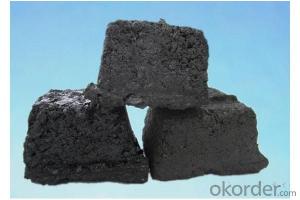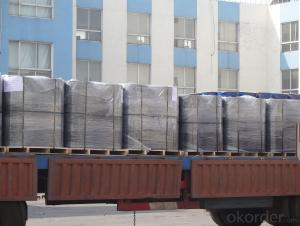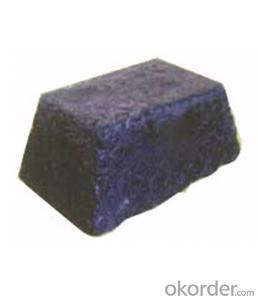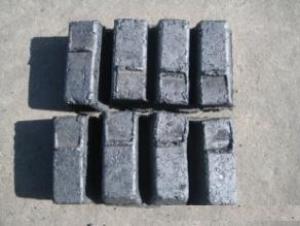Low Ash Carbon Electrode Paste Block Good Delivery Time
- Loading Port:
- Tianjin
- Payment Terms:
- TT OR LC
- Min Order Qty:
- 0 m.t.
- Supply Capability:
- 30000 m.t./month
OKorder Service Pledge
OKorder Financial Service
You Might Also Like
Spcifications
1:carbon eletrode paste
2:for ferroalloy,calcium carbide manufacture
3:HS 3801300000,YB/T5212-1996,ISO9001:2008
Product Description
Carbon Electrode Paste is a self-baking electrode used in submerged arc furnaces for delivering power to the charge mix. Electrode Paste is added to the top of the electrode column in either cylindrical or briquette form. As the paste moves down the electrode column the temperature increase causes the paste to melt and subsequently bake forming a block of electrically conductive carbon. Electrode Paste is essentially a mix of Electrically Calcined Anthracite (ECA) or Calcined Petroleum Coke (CPC) with Coal Tar Pitch.
Graphite/Carbon Electrode Paste
Specification/Item |
|
|
|
|
|
|
Ash | 4.0%max | 5.0%max | 6.0%max | 7.0% Max | 9.0% Max | 11.0% Max |
VM | 12.0%-15.5% | 12.0%-15.5% | 12.0%-15.5% | 9.5.0%-13.5% | 11.5%-15.5% | 11.5%-15.5% |
Compress Strength | 18.0Mpa Min | 17.0Mpa Min | 15.7Mpa Min | 19.6Mpa Min | 19.6Mpa Min | 19.6Mpa Min |
Specific Resistance | 65μΩm Max | 68μΩm Max | 75μΩm Max | 80μΩm Max | 90μΩm Max | 90μΩm Max |
Bulk Density | 1.38G/CM3 Min | 1.38G/CM3 Min | 1.38G/CM3 Min | 1.38G/CM3 Min | 1.38G/CM3 Min | 1.38G/CM3 Min |
Spcifications
1:carbon eletrode paste
2:for ferroalloy,calcium carbide manufacture
3:HS 3801300000,YB/T5212-1996,ISO9001:2008
Pictures
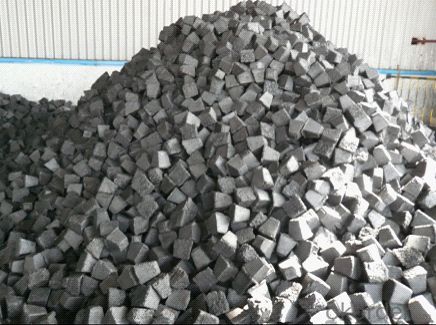
- Q: I just decoration, do not understand, JS run, please feel free to show.
- Carbon fiber in Yuba last year is very fire, but this year the world's gold tube Yuba, Yuba carbon fiber words this year to buy a cheaper, less than 300 will be shipping home...LED is currently the most high-end gold tube Yuba, adopts imported nano powder coating technology and U type stainless steel mirror groove in the original gold tube bath on the basis of the upgrade, the pipe also bold thickening, the heating effect is very good. There are intelligent temperature control equipment, very safe.... The biggest characteristic is that the lighting has been replaced by LED lighting, which is the best lighting equipment at present... Industry is in the starting stage, like the rain the sun came out only at the end of June, now a lot cheaper to buy, will certainly increase the business trick,
- Q: What is the role of carbon 60 in industry? Can it be interchanged with the chemical properties of carbon? What is the chemical structure of carbon 60?
- Used to strengthen metals; used as a new catalyst for storage of gases
- Q: How does carbon dioxide contribute to ocean acidification?
- Ocean acidification is caused by the presence of carbon dioxide, which forms carbonic acid when it dissolves in seawater. This reaction results in an increase in hydrogen ions and a decrease in pH, making the water more acidic. Human activities, especially the burning of fossil fuels, are leading to a rise in carbon dioxide emissions. As a result, more carbon dioxide is being absorbed by the oceans, disrupting the natural balance between atmospheric and oceanic carbon dioxide levels. This excess absorption leads to an accumulation of carbon dioxide in the seawater. The increased acidity of the seawater poses a significant threat to marine life. Many organisms, such as corals, shellfish, and certain types of plankton, rely on calcium carbonate to construct their shells or skeletons. However, in more acidic water, the availability of carbonate ions, necessary for calcium carbonate formation, decreases. Consequently, these organisms struggle to build and maintain their protective structures, rendering them more susceptible to predation and other dangers. Ocean acidification also has adverse effects on the growth, development, and behavior of numerous other marine species. For example, it can disrupt fish reproductive cycles and alter the behavior of certain species, making them more vulnerable to predators or adversely affecting their ability to locate food or mates. Moreover, ocean acidification can trigger a chain reaction that impacts entire marine ecosystems. The interconnectedness of species in complex food webs means that any disturbance to one species can have far-reaching consequences for others. If the population of a particular fish species declines due to acidification, it can have a ripple effect on the entire food chain, influencing the abundance and distribution of other species. In conclusion, the process of ocean acidification occurs as carbon dioxide dissolves in seawater and forms carbonic acid, resulting in an increase in hydrogen ions and a decrease in pH. This process has detrimental effects on marine organisms, particularly those reliant on calcium carbonate for their shells or skeletons. It also disrupts the growth, development, and behavior of various marine species and can have cascading impacts on entire ecosystems.
- Q: How does carbon affect the formation of air pollution in urban areas?
- Air pollution in urban areas is significantly influenced by carbon, which exists in the form of carbon dioxide (CO2) and carbon monoxide (CO). Urban areas are characterized by high population density and intense human activities, resulting in increased emissions of carbon-based pollutants. The burning of fossil fuels like coal, oil, and natural gas releases carbon dioxide into the atmosphere, contributing to global warming and climate change. In urban areas, the combustion of fossil fuels for energy production, transportation, and heating purposes emits substantial amounts of carbon dioxide. The accumulation of CO2 in the atmosphere traps heat, causing the urban heat island effect and exacerbating air pollution issues. Another carbon-based pollutant, carbon monoxide, primarily originates from vehicle exhausts and industrial processes. In urban areas with heavy traffic congestion, carbon monoxide levels tend to be high. This gas is particularly harmful as it impairs the blood's oxygen-carrying ability, resulting in various health problems, especially for individuals with pre-existing respiratory conditions. Moreover, the presence of carbon in urban areas promotes the formation of secondary air pollutants like ozone and particulate matter. Carbon reacts with other pollutants, such as nitrogen oxides (NOx) and volatile organic compounds (VOCs), under sunlight, leading to the creation of ground-level ozone. Ozone is a harmful gas that causes respiratory issues and harms vegetation. Additionally, carbon-based pollutants contribute to the generation of fine particulate matter (PM2.5) in urban areas. These particles are small enough to be inhaled deep into the lungs, causing respiratory and cardiovascular problems. Particulate matter also reduces visibility, leads to smog formation, and deposits harmful substances on surfaces. To combat air pollution in urban areas, it is crucial to reduce carbon emissions. This can be achieved through various strategies, including promoting clean energy sources, implementing stricter emission standards for vehicles and industries, and encouraging sustainable transportation options like public transit and cycling. By addressing carbon emissions, we can effectively reduce air pollution and enhance the overall air quality in urban areas, resulting in healthier and more sustainable cities.
- Q: Excuse me, carbon steel, carbon steel pipe, seamless steel pipe, spiral steel pipe, what is the difference?
- These nouns do not seem to be a method of division.Carbon steel pipe: refers to the pipe material is carbon steel, from the material on the pipeline division. A pipe that is different from stainless steel pipes and other materials;Carbon steel plate: refers to the pipe rolls are made of carbon steel, divided from making method. It is different from seamless steel tube and spiral steel tube.
- Q: How does carbon contribute to the strength of composite materials?
- The strength of composite materials is enhanced by carbon due to its distinctive properties and its ability to form robust chemical bonds. Carbon fibers or nanoparticles, when utilized, provide the composite material with both high tensile strength and stiffness. For reinforcing composite materials, carbon fibers are highly suitable due to their exceptional strength and lightweight nature. These fibers consist of tightly packed and aligned long, thin strands of carbon atoms. When incorporated into a matrix material like epoxy resin, the carbon fibers evenly distribute stress throughout the composite, thereby increasing its overall strength. The strength of composites is also influenced by the strong chemical bonds between carbon atoms. Carbon atoms have the capability to form covalent bonds that are both highly durable and stable. These bonds enable carbon to withstand significant levels of stress and deformation without fracturing, thereby making it an outstanding reinforcement material. In addition, carbon's high thermal conductivity facilitates efficient heat transfer away from the composite material, thereby preventing overheating and potential damage. This property is particularly significant in applications that involve temperature fluctuations or require high heat dissipation, such as the aerospace or automotive industries. In conclusion, carbon's unique properties, such as its high tensile strength, stiffness, strong chemical bonds, and thermal conductivity, play a crucial role in enhancing the strength and performance of composite materials.
- Q: What is carbon black filler?
- Carbon black filler is a type of material made from fine particles of carbon that is added to various products, such as rubber, plastics, and inks, to improve their strength, durability, and color.
- Q: But their chemical symbols are different, so they are different elements, different substances, but they feel the same thing... Tangled up ~!
- No one is the same. Lead is poisonous, and pencil lead is lead. The structure of carbon is the same as that of diamonds. Generally speaking, they are of structure, density and composition. No one is the same
- Q: What are the different types of carbon-based alloys?
- There are several types of carbon-based alloys, including cast iron, steel, and stainless steel. Cast iron is a strong and brittle alloy with a high carbon content, while steel is a versatile and strong alloy with varying carbon content. Stainless steel is a corrosion-resistant alloy that contains a higher percentage of chromium and nickel.
- Q: What are the effects of carbon emissions on the stability of grasslands?
- Grasslands are significantly impacted by carbon emissions, which have various negative effects. One major consequence is the modification of the climate, particularly through the greenhouse effect. Carbon dioxide (CO2) is a primary greenhouse gas, and the higher concentration of CO2 in the atmosphere leads to global warming. This rise in temperature disrupts the natural growth patterns of grasslands and disturbs the delicate balance of their ecosystems. The increased temperatures caused by carbon emissions can result in higher rates of evaporation, leading to drier soil conditions. Grasslands are adapted to specific levels of moisture, and any alterations in these conditions can reduce plant growth and increase vulnerability to drought. Consequently, grasslands become less stable and more susceptible to desertification. Furthermore, elevated levels of carbon dioxide can impact the nutritional quality of grasses. As CO2 concentrations rise, the relative proportion of essential nutrients in grasses may decrease. This phenomenon, called nutrient dilution, can affect the health and productivity of herbivores that depend on these grasslands for sustenance. The decline in nutritional value disrupts the delicate balance of predator-prey relationships and contributes to a decrease in biodiversity. In addition, carbon emissions contribute to soil acidification. Increased carbon dioxide dissolves in rainwater, forming carbonic acid, which lowers the pH of the soil. Grasses are sensitive to changes in soil pH, and acidification negatively affects their growth and nutrient absorption. Acidic soil conditions can also lead to the loss of crucial microorganisms that contribute to a healthy soil ecosystem, further destabilizing grasslands. Lastly, carbon emissions indirectly affect grasslands through climate change-induced changes in precipitation patterns. Shifts in rainfall patterns can alter the composition and distribution of plants, favoring invasive species or disrupting the competitive balance between different grass species. This disturbance can compromise the stability and functioning of grassland ecosystems. In conclusion, carbon emissions have multiple detrimental effects on the stability of grasslands, including climate changes, increased susceptibility to drought, nutrient dilution, soil acidification, and alterations in precipitation patterns. It is essential to reduce carbon emissions and mitigate the impacts of climate change to preserve the stability and integrity of grassland ecosystems.
Send your message to us
Low Ash Carbon Electrode Paste Block Good Delivery Time
- Loading Port:
- Tianjin
- Payment Terms:
- TT OR LC
- Min Order Qty:
- 0 m.t.
- Supply Capability:
- 30000 m.t./month
OKorder Service Pledge
OKorder Financial Service
Similar products
Hot products
Hot Searches
Related keywords
